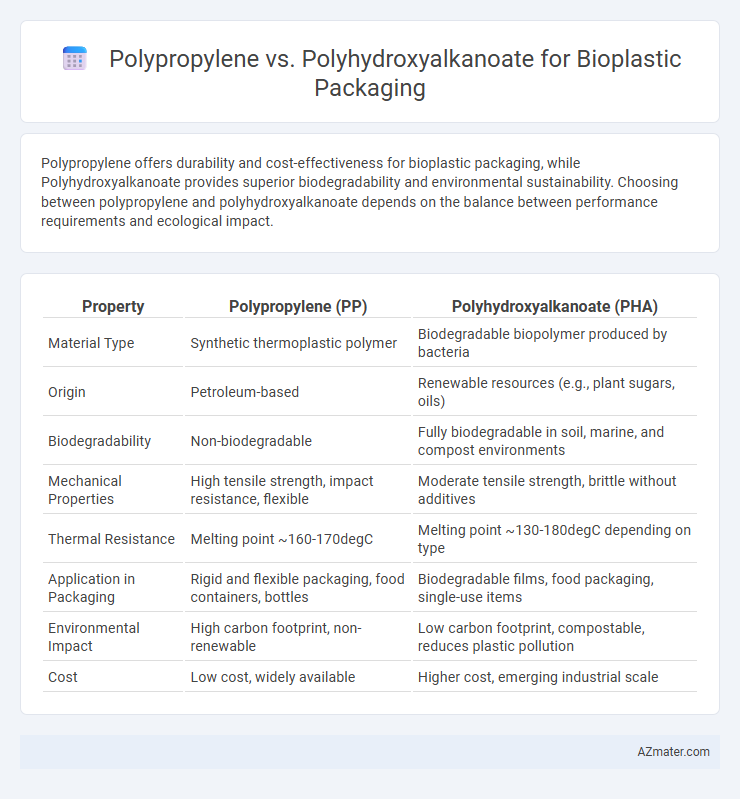Polypropylene offers durability and cost-effectiveness for bioplastic packaging, while Polyhydroxyalkanoate provides superior biodegradability and environmental sustainability. Choosing between polypropylene and polyhydroxyalkanoate depends on the balance between performance requirements and ecological impact.
Table of Comparison
| Property | Polypropylene (PP) | Polyhydroxyalkanoate (PHA) |
|---|---|---|
| Material Type | Synthetic thermoplastic polymer | Biodegradable biopolymer produced by bacteria |
| Origin | Petroleum-based | Renewable resources (e.g., plant sugars, oils) |
| Biodegradability | Non-biodegradable | Fully biodegradable in soil, marine, and compost environments |
| Mechanical Properties | High tensile strength, impact resistance, flexible | Moderate tensile strength, brittle without additives |
| Thermal Resistance | Melting point ~160-170degC | Melting point ~130-180degC depending on type |
| Application in Packaging | Rigid and flexible packaging, food containers, bottles | Biodegradable films, food packaging, single-use items |
| Environmental Impact | High carbon footprint, non-renewable | Low carbon footprint, compostable, reduces plastic pollution |
| Cost | Low cost, widely available | Higher cost, emerging industrial scale |
Introduction to Bioplastics in Packaging
Bioplastics like Polypropylene (PP) and Polyhydroxyalkanoate (PHA) offer sustainable alternatives to traditional petroleum-based plastics in packaging applications. PP is widely used due to its durability, flexibility, and cost-effectiveness, whereas PHA, derived from microbial fermentation, provides biodegradability and eco-friendly disposal options. The choice between PP and PHA hinges on balancing performance requirements with environmental impact considerations in bioplastic packaging solutions.
Overview of Polypropylene (PP)
Polypropylene (PP) is a widely used thermoplastic polymer known for its versatility, chemical resistance, and durability in packaging applications. It offers excellent moisture barrier properties, high tensile strength, and thermal stability, making it suitable for various bioplastic packaging products. Despite being derived from fossil fuels, PP's recyclability and cost-effectiveness maintain its dominance in packaging markets compared to biopolymers like polyhydroxyalkanoates (PHA).
Overview of Polyhydroxyalkanoate (PHA)
Polyhydroxyalkanoate (PHA) is a biodegradable biopolymer produced by microbial fermentation of renewable resources, offering a sustainable alternative to conventional plastics such as polypropylene. PHA exhibits excellent biodegradability in various environments, including soil and marine conditions, making it ideal for single-use packaging applications. Compared to polypropylene, PHA has superior environmental benefits due to its carbon-neutral lifecycle and lower greenhouse gas emissions during production.
Production Processes: PP vs PHA
Polypropylene (PP) production involves polymerizing propylene through catalytic processes such as Ziegler-Natta or metallocene catalysts, resulting in a petroleum-based thermoplastic with high scalability and cost efficiency. Polyhydroxyalkanoates (PHA) are biosynthesized by microbial fermentation of renewable substrates like sugars or lipids, followed by extraction and purification, making the production process more complex and dependent on bioreactor conditions. PP's established petrochemical production contrasts with PHA's sustainable but currently less mature biotechnological manufacturing, impacting factors like environmental footprint and industrial feasibility.
Mechanical and Physical Properties Comparison
Polypropylene (PP) exhibits high tensile strength, excellent impact resistance, and superior thermal stability, making it suitable for rigid and durable bioplastic packaging applications. Polyhydroxyalkanoate (PHA) offers biodegradability with moderate tensile strength and flexibility but generally lower thermal resistance compared to polypropylene. The physical density of PP ranges from 0.90 to 0.91 g/cm3, while PHA typically varies between 1.18 to 1.30 g/cm3, influencing the packaging weight and barrier properties.
Environmental Impact and Biodegradability
Polypropylene (PP) is a widely used petroleum-based plastic known for its durability but contributes significantly to environmental pollution due to its slow degradation in landfills. Polyhydroxyalkanoate (PHA) is a biopolymer produced by microbial fermentation of renewable resources, offering excellent biodegradability and compostability under natural conditions. Compared to PP, PHA reduces carbon footprint, minimizes microplastic formation, and supports sustainable packaging solutions with lower environmental impact.
Cost and Market Availability
Polypropylene (PP) dominates the bioplastic packaging market due to its low production cost, averaging around $1.00 to $1.50 per kilogram, and widespread availability in global supply chains. In contrast, Polyhydroxyalkanoate (PHA) remains significantly more expensive, with prices ranging from $4.00 to $8.00 per kilogram, limiting its large-scale adoption despite its biodegradability. Market availability of PP is extensive because of established petrochemical infrastructure, while PHA production is constrained by limited fermentation capacity and higher raw material expenses, restricting its commercial scale.
Food Safety and Regulatory Compliance
Polypropylene (PP) is widely used in food packaging due to its excellent chemical resistance, high melting point around 160degC, and compliance with FDA and EFSA regulations, ensuring food safety and preventing contamination. Polyhydroxyalkanoates (PHAs), biodegradable bioplastics derived from microbial fermentation, meet food contact standards but have lower thermal stability and mechanical strength compared to PP, which can limit their application in heat-intensive packaging processes. Regulatory frameworks for both materials require stringent migration testing and compliance with specific food safety standards, but PHAs offer environmental benefits through compostability without compromising basic food safety requirements.
Applications in Packaging Industries
Polypropylene (PP) dominates packaging industries due to its excellent mechanical strength, chemical resistance, and low cost, making it ideal for rigid containers, films, and caps. Polyhydroxyalkanoates (PHAs) offer biodegradable and compostable alternatives, increasingly preferred for food packaging, disposable items, and eco-friendly labels, supporting sustainability goals. Growing demand for circular economy solutions drives the adoption of PHAs despite higher costs, while PP remains prevalent in long-lasting, high-performance packaging applications.
Future Trends and Innovations
Polyhydroxyalkanoate (PHA) is gaining traction over polypropylene (PP) in bioplastic packaging due to its complete biodegradability and compostability, aligning with increasing regulatory and consumer demand for sustainable materials. Innovations in microbial fermentation and genetic engineering are enhancing PHA production efficiency and performance, making it more competitive with PP's durability and cost-effectiveness. Future trends suggest hybrid materials combining the mechanical strengths of PP with PHA's eco-friendly properties could revolutionize packaging solutions, reducing plastic pollution and advancing circular economy goals.

Infographic: Polypropylene vs Polyhydroxyalkanoate for Bioplastic packaging
 azmater.com
azmater.com